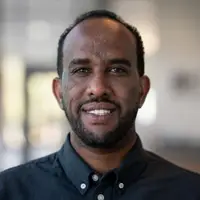Groundwater is an essential natural source of fresh water for people across the globe. However, climate and weather-related impacts are quickly diminishing this precious resource.
To help us understand the challenges, Mohamed Abdinoor (MA), Senior Private Sector and Resilience Advisor at RTI International, and Michael Kane (MK), Director of the RTI Center for Water Resources, will be sharing different perspectives related to their expertise in water and environmental sciences.
What is groundwater and why is it important? How is groundwater used differently on a national scale? On a global scale? How about from rural to urban settings?
MA: Groundwater sources provide critical support to livelihoods such as in agriculture, fishing, and livestock husbandry. At the national scale, groundwater provides support to a country’s economic growth. Globally, there are transboundary water sources such as oceans, lakes and rivers that are shared across countries. In rural areas, groundwater comes from wells and provides drinking water for animals and humans. In contrast, urban areas use more piped water.
MK: Groundwater is water underground that infiltrated from rainfall or lakes and streams into the cracks and spaces in soil, sand, and rock. These defined layers are called aquifers. To answer the question of importance, let’s take a step back and look at all the water on Earth. More than 96% of all water is salt water in the oceans. In addition, 1.7% is locked up in ice caps and glaciers. So, available freshwater is a very small part of the water on Earth, and most of that available freshwater is in groundwater - much more than is in lakes, rivers, and streams.
About 65% of groundwater used in the United States goes to providing irrigation for crops, with the rest supplying drinking water. These numbers are fairly consistent on a global scale as well. There is great regional variation however, for example in dry environments like the Middle East, where over 90% of groundwater is used for irrigation.
In many regions, shifting weather patterns are expected to reduce the amount of groundwater available for agriculture and livestock. What are the most pressing environmental impacts or concerns regarding groundwater?
MA: One of the impacts is the reduction of precipitation or unpredictable patterns of rain and water temperatures. This will affect the availability of water sources, especially in sub-Saharan Africa, where the majority of livelihoods depend on water sources. Currently in the Horn of Africa, we’re seeing unprecedented drought conditions every 2-3 years affecting millions of lives and livelihoods.
MK: Changing patterns are expected to reduce precipitation and increase temperatures in many areas of the globe. Less precipitation will reduce the amount of groundwater recharge and warmer temperatures will increase evaporation and the demand for groundwater. When there is a reduction in rainfall, irrigators must rely more heavily on groundwater sources, so they pump more from the aquifer. Additional pumping means withdrawing water faster than can be recharged, which results in the groundwater levels dropping. This leads to smaller wells drying up, reduced water in streams and lakes, land subsidence, and saltwater intrusion into what had been a freshwater aquifer.
How can communities and businesses be more conscious of protecting this resource?
MA: First, community awareness and sensitization on conserving trees and habitats is critical. More importantly governments need to institutionalize polices and measures that protect these resources; transboundary or regional initiatives need to be put in place to protect resources across countries. Businesses need to abide by sustainable and ethical practices.
MK: I think a big part of protecting any resource starts with making people aware of the fragility of that resource, and we need to do a better job of this. For protecting groundwater:
- People need to be educated that what we do on the surface of the land can impact groundwater supplies. Any hazardous spills or application of pesticides or fertilizers can eventually get into groundwater supplies.
- Everyone needs to be aware of the importance of conserving water. By reducing the water we use at the tap, we are impacting the amount of water taken from the ground.
- At the community level, we need to remain aware that land use changes impact aquifer recharge – deforestation, a decline in wetlands, and polluted surface water runoff, all connect with a reduction in groundwater supplies.
Can conserving groundwater be a solution to environmental changes and impacts? How so?
MA: Yes. Some examples of sustainable solutions to protecting groundwater sources include reduced human activities along rivers and water sources, sustainable management of fish stocks, and balancing livestock in grazing areas through promotion of healthy herds and pasturing.
MK: A big part of improving our resilience is understanding what the potential impacts are (some are already happening) and being ready for them. I believe that we need to take a wholistic approach to environmental resilience, because everything in the global ecosystem is inter-connected. Yes, we need to conserve water – but that means so much more than just taking shorter showers. Since most of the water we use goes to irrigating crops, improving efficiency in that area will have a significant impact and could increase crop yields. Maximizing yields is important because we will see a reduction in arable land resulting from environmental changes. Large amounts of water are used for energy production – therefore, increased use of sustainable energy will reduce our water demand and improve air quality. Maintaining wetlands and accounting for urban water runoff will not only help increase aquifer recharge rates, but will also reduce pollution, mitigate flood impacts, and enhance environmental quality.
In a world where the value of groundwater will only increase; how can we ensure that communities are set up for sustainable futures, in which people are not deprived of this essential resource?
MA: Sustainable resource sharing is critical for prosperity. As impacts are increasingly being felt across the world, some communities will be affected more than others. We must strive to ensure all communities have access to water sources for their health and livelihoods. There are some excellent examples of sustainable resource management practices. For example, among the Pastoralist communities of Southern Ethiopia, they employ traditional, but effective practices to sustainably manage using water, pasture/grazing land, dry seasons versus rainy seasons, management of livestock, and conflicts or disputes over resources are managed through community systems.
MK: Again, I think it goes back to public education and awareness. We now have the tools and models that show us how shifting weather patterns are going to impact every facet of our lives. Therefore, we can use those same tools to help us make the best preparations for what’s coming. This involves more than just identifying updates to infrastructure or behavioral changes we need to make. Using the tools, we can also determine the areas most vulnerable to water shortages, and the best ways to ensure they become more resilient.

